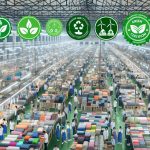When you’re on the hunt for performance fabrics made with closed-loop processes, it’s essential to understand how these sustainable textiles are created. You’ll want to focus on materials like recycled polyester and nylon, backed by certifications such as the Global Recycled Standard. But identifying the right brands and technologies can be tricky. What should you look for in manufacturing practices, and how do these innovations impact the future of sustainable textiles?
Table of Contents
Key Takeaways
- Research brands that utilize closed-loop processes, focusing on those that recycle materials at every stage of textile manufacturing.
- Look for certifications like Global Recycled Standard (GRS) to validate the sustainability of performance fabrics.
- Explore fabric options made from recycled fibers, such as recycled polyester and nylon, promoting resource efficiency.
- Investigate brands employing innovative recycling technologies, including chemical and mechanical recycling, for high-quality performance fabrics.
- Engage with brands that prioritize transparency in sourcing and ethical manufacturing practices for accountability in sustainable textiles.
Understanding Closed-Loop Processes in Textile Manufacturing
When you explore textile manufacturing, understanding closed-loop processes is essential because they markedly reduce waste and environmental impact.
These processes recycle materials at every stage, ensuring that fibers and fabrics can be reused instead of ending up in landfills. When a product reaches the end of its life, it’s collected, sorted, and transformed back into usable raw materials.
This method minimizes the use of virgin resources and lowers energy consumption during production. By choosing brands that implement closed-loop systems, you support sustainable practices and help create a circular economy.
You’ll find that this approach not only benefits the environment but also promotes innovation in design and manufacturing, leading to high-quality, durable textiles.
Embrace these principles in your fabric choices.
Identifying Performance Fabrics Suitable for Sustainability
Performance fabrics play an essential role in sustainable textile choices, combining functionality with eco-friendly materials.
When you’re selecting these fabrics, look for those made from recycled fibers, like recycled polyester or nylon. These materials reduce waste and minimize environmental impact.
Additionally, check for certifications such as Global Recycled Standard (GRS) or OEKO-TEX, ensuring the fabric meets sustainability criteria.
You’ll also want to take into account the durability of the fabrics; longer-lasting materials mean less frequent replacements, contributing to sustainability.
Finally, explore brands committed to ethical manufacturing processes, as transparency in sourcing and production is critical.
Exploring Recycling Technologies for Performance Textiles
How can advancements in recycling technologies transform the domain of performance textiles?
You can leverage innovative recycling methods to turn discarded materials into high-quality fabrics. Technologies like chemical recycling break down polyester and nylon into their original monomers, allowing for the creation of new fibers without losing performance characteristics.
Mechanical recycling offers an alternative by shredding and re-spinning fabrics, which helps reduce waste and energy consumption. By choosing brands that utilize these technologies, you contribute to a circular economy and minimize your environmental footprint.
Additionally, these advancements can inspire new design possibilities, enhancing the functionality and durability of recycled textiles.
Sustainable Production Practices in the Textile Industry
In today’s textile industry, optimizing resource efficiency is essential for sustainable production.
You’ll want to explore how companies are adapting their supply chains to minimize waste and reduce their environmental impact.
Resource Efficiency Optimization
Optimizing resource efficiency is essential for sustainable production practices in the textile industry. By focusing on minimizing waste and maximizing resources, you can greatly reduce your environmental impact.
Here are some effective strategies to take into account:
- Utilize eco-friendly materials: Choose organic or recycled textiles that require less water and energy during production.
- Implement advanced technologies: Use digital printing or automated cutting to minimize fabric waste and energy consumption.
- Enhance water management: Adopt closed-loop water systems to recycle and purify water, reducing consumption and pollution.
Supply Chain Adaptation Strategies
With resource efficiency optimization setting the groundwork for sustainable practices, adapting supply chain strategies becomes an essential next step in the textile industry.
You should focus on sourcing materials from certified suppliers who prioritize eco-friendly processes. Collaborating with local manufacturers can reduce transportation emissions and support community economies.
Implementing transparent practices allows you to trace the lifecycle of your fabrics, ensuring sustainability throughout. Utilizing technology for real-time inventory management can minimize waste, aligning production with actual demand.
Additionally, investing in training for your team on sustainability can foster a culture of responsibility.
Engaging Consumers in the Circular Economy
As consumers become increasingly aware of their environmental impact, engaging them in the circular economy is essential for fostering sustainable practices.
You can make a difference by understanding your role in this system and taking simple actions:
- Choose brands committed to sustainability: Support companies that prioritize closed-loop processes and eco-friendly materials.
- Participate in recycling programs: Many brands offer take-back initiatives, allowing you to return used items for recycling or repurposing.
- Educate yourself and others: Share knowledge about the benefits of circular fashion to inspire friends and family.
Innovations in Closed-Loop Textile Technologies
As you explore innovations in closed-loop textile technologies, you’ll find that mechanical and chemical recycling methods are making significant strides.
These breakthroughs are reshaping how we think about fabric waste and sustainability.
Plus, data-driven optimization techniques are enhancing efficiency, ensuring that more materials are reused effectively.
Mechanical Recycling Advances
Although the textile industry has long faced challenges in sustainability, mechanical recycling advances are paving the way for innovative closed-loop technologies.
These advancements allow you to transform used textiles into new, high-performance fabrics without compromising quality. Here are some key innovations you should know:
- Fiber Recovery: New techniques efficiently separate fibers from blended fabrics, enabling higher-quality material reuse.
- Energy Efficiency: Modern mechanical recycling processes consume considerably less energy compared to traditional methods, reducing the overall carbon footprint.
- Quality Control: Enhanced sorting technologies guarantee that only the best materials enter the recycling stream, yielding superior end products.
Chemical Recycling Breakthroughs
Chemical recycling breakthroughs are transforming the textile industry by enabling the breakdown of used fabrics into their original chemical components, allowing for the creation of new fibers without the loss of quality.
These innovative processes help reduce waste and reliance on virgin materials, making your fabric choices more sustainable. You’ll find that brands are increasingly adopting chemical recycling methods to create performance fabrics that maintain durability and functionality.
Look for labels that highlight these advancements, as they signal a commitment to environmental responsibility. By choosing textiles made from chemically recycled materials, you’re supporting a closed-loop system that minimizes environmental impact while enjoying high-quality performance in your fabrics.
It’s a win-win for you and the planet!
Data-Driven Optimization Techniques
While the textile industry embraces sustainable practices, data-driven optimization techniques are revolutionizing closed-loop systems. These innovations enhance efficiency, reduce waste, and improve the overall quality of performance fabrics.
By leveraging data analytics, manufacturers can make smarter decisions throughout the production process. Here’s how you can benefit from these techniques:
- Predictive Analytics: Anticipate material needs and streamline inventory management.
- Performance Monitoring: Track fabric durability and sustainability metrics in real-time, ensuring high-quality output.
- Resource Optimization: Identify areas to minimize energy and water consumption, leading to a smaller ecological footprint.
With these approaches, you’ll not only contribute to eco-friendly practices but also achieve superior performance in your textiles.
Explore these data-driven strategies to stay ahead in the sustainable fabric revolution!
Market Trends and the Future of Sustainable Fabrics
Sustainable fabrics are reshaping the textile industry, reflecting a growing demand for eco-friendly options among consumers and manufacturers alike.
You’ll notice brands prioritizing transparency in their supply chains, using recycled materials, and adopting closed-loop processes. This shift isn’t just a trend; it’s a necessary response to climate change and resource scarcity.
You might also see innovations in fabric technology, such as waterless dyeing and biodegradable textiles, making sustainability more accessible than ever.
As consumers become more eco-conscious, you’ll find that companies are increasingly held accountable for their practices.
Embracing these sustainable fabrics not only benefits the planet but also enhances your wardrobe with high-performance, stylish options.
The future of textiles lies in this harmonious blend of sustainability and functionality.
Frequently Asked Questions
How Can I Verify if a Fabric Is Recycled?
You wouldn’t buy a car without checking its history, right? Similarly, verify a fabric’s recycled status by researching certifications, asking manufacturers for details, and looking for labels like Global Recycled Standard to guarantee authenticity.
Are Closed-Loop Fabrics Machine-Washable and Durable?
Yes, closed-loop fabrics are often machine-washable and designed for durability. You’ll find that they maintain their quality through multiple washes, making them a practical choice for everyday use and active lifestyles.
What Certifications Should I Look for in Sustainable Fabrics?
When you seek sustainable fabrics, look for certifications like GOTS for organic textiles and OEKO-TEX for safety. These labels signal quality and environmental commitment, ensuring you’re making responsible choices without sacrificing performance or durability.
Can Closed-Loop Fabrics Be Customized for Specific Needs?
Yes, you can customize closed-loop fabrics to meet your specific needs. Many manufacturers offer various options regarding texture, color, and performance features, allowing you to tailor the fabric perfectly for your project.
Where Can I Find Retailers Offering Closed-Loop Performance Fabrics?
You can find retailers offering closed-loop performance fabrics by checking online marketplaces, specialty fabric stores, and eco-conscious brands. Don’t forget to explore local boutiques that focus on sustainable and innovative textile options.
- Stop Indigo Dye Bleeding From Your Jeans - June 10, 2025
- The Definitive Guide to Setting Dye in Fabric - June 10, 2025
- How to Treat Fabric Bleeding Stains on White Clothes - June 10, 2025







